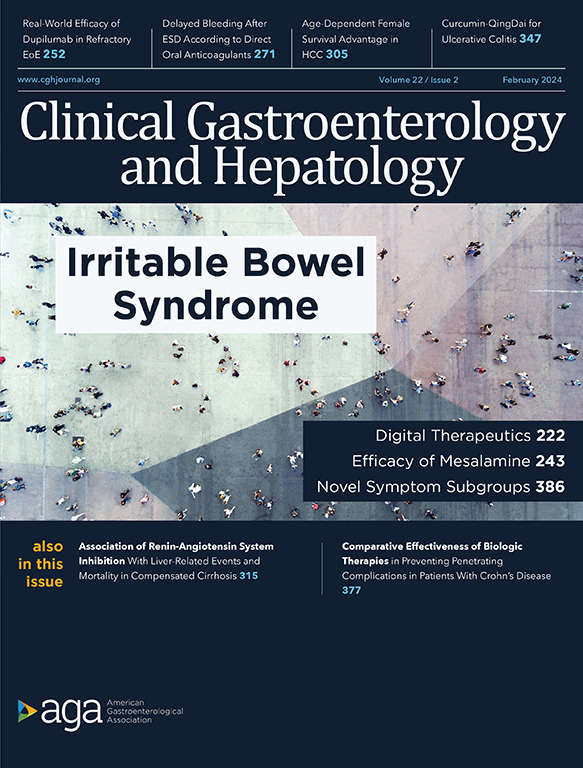Biomarkers for Prediction of Alcohol-Related Liver Cirrhosis: A General Population–Based Swedish Study of 537,250 Individuals
IF 11.6
1区 医学
Q1 GASTROENTEROLOGY & HEPATOLOGY
引用次数: 0
Abstract
Background and Aims
The study sought to examine which biomarkers have the best predictive capabilities for future alcohol-related liver cirrhosis (ARLC) in a general population setting.
Method
This population-based cohort study includes approximately 35% of the inhabitants of Stockholm County who had left a blood sample at an outpatient visit in primary care or occupational health screening from 1985 to 1996. All subjects with a blood sample measurement of alanine aminotransferase and aspartate aminotransferase (AST) were included, exclusions were made for persons with known liver disease. We ascertained incident ARLC by linkage to Swedish national health registers between to the end of 2011. Associations between biomarkers and incident ARLC were analyzed with Cox regression models and discrimination was assessed using C-statistics.
Results
In all, 537,230 adult subjects were included. The mean age was 45 years and 53% were men. During a mean follow-up of 19.0 years, 2725 (0.51%) subjects developed ARLC. The biomarkers with the highest discrimination (C-index) for incident ARLC at 5 years were: AST (0.89), mean corpuscular volume (0.88), and γ-glutamyltransferase (0.81). Scoring systems including Fibrosis-4 (0.86) and the AST/alanine aminotransferase ratio (0.81) performed similarly well. The negative predictive value for ARLC was generally high (∼99.6%) across biomarkers, using routine clinical cutoffs to identify pathological values. However, positive predictive values were generally low (0.6%–15.9%).
Conclusions
Biomarkers commonly used in primary care settings are highly associated with incident ARLC in the general population. Elevation of these commonly available biomarkers should prompt consideration of further investigation of a possible high level of alcohol consumption.
预测与酒精相关的肝硬化的生物标志物--一项基于瑞典普通人群的研究,研究对象为 537 250 人。
背景和目的研究在普通人群中,哪些生物标志物对未来酒精相关性肝硬化(ARLC)具有最佳预测能力:这项基于人群的队列研究包括斯德哥尔摩县约 35% 的居民,他们在 1985 年至 1996 年期间的初级保健门诊或职业健康检查中留取了血液样本。所有血样中检测到谷丙转氨酶(ALT)和谷草转氨酶(AST)的受试者都被包括在内,但不包括已知患有肝病的人。我们通过与 2011 年底前的瑞典国家健康登记册进行链接,确定了 ARLC 的发病情况。我们使用Cox回归模型分析了生物标志物与ARLC事件之间的关联,并使用C统计量评估了区分度:共纳入 537 230 名成年受试者。平均年龄为 45 岁,53% 为男性。在平均 19.0 年的随访期间,有 2725 名受试者(0.51%)罹患 ARLC。对 5 年后发生的 ARLC 识别率(C 指数)最高的生物标志物是谷草转氨酶(0.89)、平均血球容积(0.88)和γ-谷氨酰转移酶(0.81)。包括FIB-4(0.86)和AST/ALT比值(0.81)在内的评分系统表现类似。使用常规临床临界值来确定病理值,各生物标志物对ARLC的阴性预测值普遍较高(∼99.6%)。然而,阳性预测值普遍较低(0.6-15.9%):结论:基层医疗机构常用的生物标志物与普通人群中的ARLC事件高度相关。这些常用生物标志物的升高应促使人们考虑进一步调查可能的大量饮酒。
本文章由计算机程序翻译,如有差异,请以英文原文为准。
求助全文
约1分钟内获得全文
求助全文
来源期刊
CiteScore
16.90
自引率
4.80%
发文量
903
审稿时长
22 days
期刊介绍:
Clinical Gastroenterology and Hepatology (CGH) is dedicated to offering readers a comprehensive exploration of themes in clinical gastroenterology and hepatology. Encompassing diagnostic, endoscopic, interventional, and therapeutic advances, the journal covers areas such as cancer, inflammatory diseases, functional gastrointestinal disorders, nutrition, absorption, and secretion.
As a peer-reviewed publication, CGH features original articles and scholarly reviews, ensuring immediate relevance to the practice of gastroenterology and hepatology. Beyond peer-reviewed content, the journal includes invited key reviews and articles on endoscopy/practice-based technology, health-care policy, and practice management. Multimedia elements, including images, video abstracts, and podcasts, enhance the reader's experience. CGH remains actively engaged with its audience through updates and commentary shared via platforms such as Facebook and Twitter.

 求助内容:
求助内容: 应助结果提醒方式:
应助结果提醒方式:


